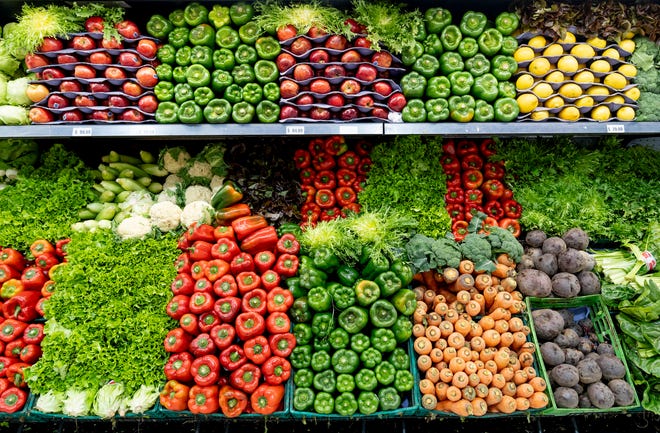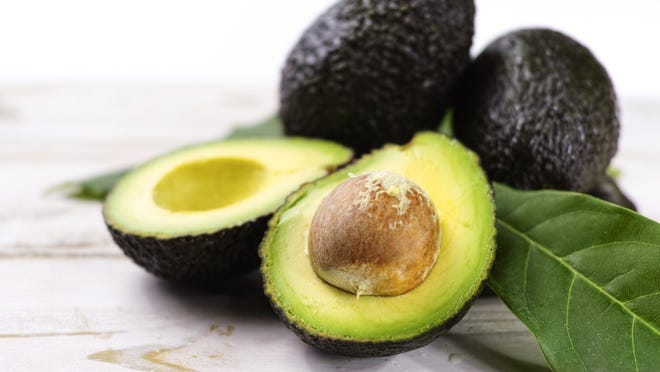Susan Selasky
Detroit Free Press
Since 2004, the Environmental Working Group (EWG) has released an annual list of fruits and vegetables the group calls the Dirty Dozen, because they're deemed to contain the most pesticides. But there are a few surprises to this year's list.
While kale has been alone in the No. 3 spot since 2019 — the first time it made the list in 10 years — the group added mustard greens and collard greens alongside it. All three are known to be low in calories, high in fiber and have antioxidant qualities. Strawberries are No. 1 and spinach comes in at No. 2 on the list.
More: Worried about your fruits and vegetables? Here's how to wash them
Bell peppers, tested for the first time since 2012, and hot peppers (chile peppers), came in at No. 10, knocking tomatoes to the No. 11 spot.
EWG's yearly Shopper’s Guide to Pesticides in Produce is based on test data from the U.S. Department of Agriculture (USDA). The group identified, according to a news release, which fresh fruits and vegetables contain the most and the least amount of pesticide residue.
Among the findings, the EWG cited included:
70% of nonorganic fresh produce sold in the U.S. had pesticides.
20 different pesticides were found in a single sample of the three leafy greens in the No. 3 spot.
115 pesticides — the highest amount — were found on bell peppers.
“Whether organic or conventionally grown, fruits and vegetables are critical components of a healthy diet,” said EWG toxicologist Thomas Galligan in a news release. “We urge consumers who are concerned about their pesticide intake to consider, when possible, purchasing organically grown versions of the foods on EWG’s Dirty Dozen, or conventional produce from our Clean Fifteen.”

Eat your veggies
The annual report is not without controversy.
What’s important to note is that dietitians and health experts recommend that the overall goal is for Americans to increase their consumption of fruits and vegetables for a healthy, well-balanced diet.
SPECIAL INTEREST OPPOSITION
The Alliance for Food and Farming (AFF), AGRABUSINESS LOBBY
strong opponents of EWG's annual list, says it shows a negative impact on fruit and vegetable consumption
WHICH IS COMPLETE BS EWG HAS NO SUCH POWER PR OR ACTIVIST AFF ON THE OTHER HAND HAS AN OVERSIZED ABILITY TO COUNTER EWG AND AS USUAL WITH CORPORATE SHILLS THEY BLAME CITIZEN ACTIVISTS FOR THE FAILURES IN THEIR INDUSTRY
“Last year, the Environmental Working Group (EWG) faced significant criticism from the nutrition community for inaccurately escalating and perpetuating consumer safety fears about these healthy foods as our world was locking down due to the pandemic,” Teresa Thorne, Executive Director of the AFF said in a news release. “EWG continues to dismiss the needs of consumers and disrespect farmers by choosing to inaccurately disparage the very foods health experts agree we should eat more of every day to improve immune function, prevent diseases and increase lifespan.”
They also point out that the USDA's Pesticide Data Program report finds that 99% of samples tested fell below the safety standards set by the Environmental Protection Agency. Additionally, more than 40% of produce tested had no detectable pesticide residue.
Only one in 10 Americans eat enough fruits and vegetables daily, according to the Centers for Disease Control and Prevention. The CDC recommends that adults eat 1½-2 cups of fruit and 2-3 cups of vegetables per day.
The AFF also points to studies that found eating five servings of fruits and vegetables a day, may reduce the risk for certain diseases. Another Tufts University study found that prescribing fruits and vegetables would prevent nearly 2 million cardiovascular events such as heart attacks, 350,000 deaths and cut health care costs by $40 billion.
The AFF finds that the EWG's Dirty Dozen list creates fear and disparages consumers from buying — organic or not.“With only one in 10 Americans eating enough fruits and vegetables each day, we should be promoting consumption to enhance immune function and prevent illness, not discouraging it with tactics like the Dirty Dozen list,” Thorne added.STRAIGHT FROM THEIR PRESS RELEASE.
Alliance for Food and Farming launches #NoMoreDirtyDozen | The Packer
MORE SPACE THAN GIVEN TO EWG
THIS IS FROM THE FP FOOD WRITER
CAN WE SAY CORPORATE SHILLING
IN THE FOOD SECTION
I AM SHOCKED SHOCKED I SAY
THIS IS ALL SHE WROTE ON THE EWG
"There is increasing evidence that low dose chronic exposure to mixture of pesticides may have adverse effects on human health, particularly during sensitive windows of development like pregnancy and childhood," Temkin said in an email to the Free Press.
EWG said it is aware that access and being able to afford organic is not always an option. That is why, they said, the group created its "Clean 15" shoppers guide.
While the EWG's list is based on USDA data, most pesticide residues detected fall within established government levels.
Along with the Dirty Dozen list, EWG releases its list of fruits and vegetables that contain the least amount of pesticides. At the top of that list is the beloved avocado. Also, on the list are asparagus, cabbage, and cauliflower — all known as nutritional all-stars.
MORE CORPORATE SHILLING IN THE FOOD SECTION
To help consumers the AFF provides an easy-to-use risk at safefruitsandveggies.com showing how many servings of a specific fruit or vegetable one would have to eat without any effect on the highest amount of pesticide residue the USDA recorded.With bell peppers that would be 196 servings for a woman in one day.
To handle fruits and vegetables safely, the FDA recommends washing them before eating or using.

EWG's list of most contaminated fruits and vegetables
Strawberries
Spinach
Kale, collard and mustard greens
Nectarines
Apples
Grapes
Cherries
Peaches
Pears
Bell and hot peppers
Celery
Tomatoes

EWG's Clean 15
Avocados
Sweet corn*
Pineapple
Onions
Papaya*
Sweet peas (frozen)
Eggplant
Asparagus
Broccoli
Cabbage
Kiwi
Cauliflower
Mushrooms
Honeydew melon
Cantaloupe


No comments:
Post a Comment